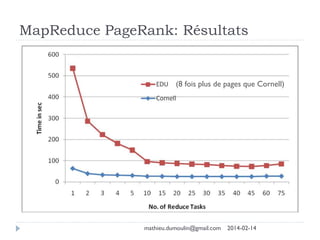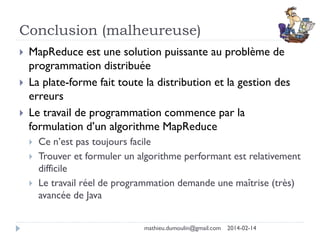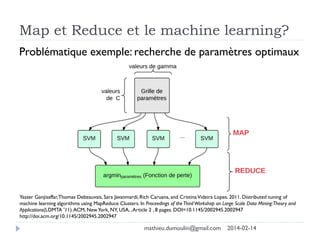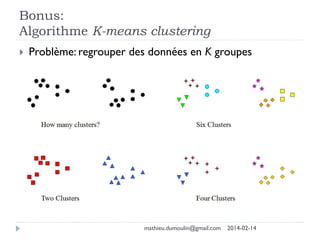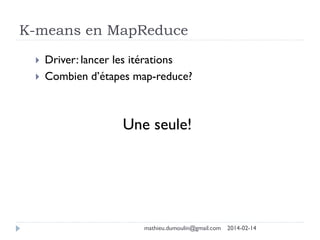Introduction aux algorithmes map reduce
- 1. Introduction aux algorithmes MapReduce Mathieu Dumoulin (GRAAL), 14 Février 2014
- 2. Plan Introduction de la problématique Tutoriel MapReduce Design d’algorithmes MapReduce Tri, somme et calcul de moyenne PageRank en MapReduce Conclusion mathieu.dumoulin@gmail.com 2014-02-14
- 3. « Big Data » Building new analytic applications based on new types of data, in order to better serve your customers and drive a better competitive advantage - David McJannet, Hortonworks Big data is high volume, high velocity, and/or high variety information assets that require new forms of processing to enable enhanced decision making, insight discovery and process optimization - Gartner, updated definition of big data (2012) mathieu.dumoulin@gmail.com 2014-02-14
- 4. Un outil spécialisé Problèmes où Hadoop est envisageable: Trop de données (GB,TB,PB) Améliorer des résultats existants Obtenir de nouveaux résultats Combiner des données hétérogènes Croissance rapide (et constante) des données Temps de traitement lent (minutes, heures) Budgets limités Plusieurs ordinateurs déjà disponibles mathieu.dumoulin@gmail.com 2014-02-14
- 5. Hadoop au cœur du big data mathieu.dumoulin@gmail.com 2014-02-14
- 6. MapReduce au cœur de Hadoop Hadoop MapReduce is a software framework for easily writing applications which process vast amounts of data (multi-terabyte data-sets) in-parallel on large clusters (thousands of nodes) of commodity hardware in a reliable, fault-tolerant manner. - Hadoop Tutorial, hadoop.apache.org mathieu.dumoulin@gmail.com 2014-02-14
- 7. Gain d’utiliser Hadoop? Tout le travail de distribution, balancement de charge, synchronisation et de gestion d’erreur est géré automatiquement Il suffit de programmer Map et Reduce (Java, C++, Python, bash, etc.) Une grappe Hadoop peut évoluer facilement en ajoutant des nœuds en tout temps Hadoop offre un rapport performance-prix très compétitif (Amazon EMS, réutilisation de PC existants, aucun coûts de licences ni de matériel spécialisé HPC) mathieu.dumoulin@gmail.com 2014-02-14
- 8. L’exemple WordCount On veut trouver les k mots les plus fréquents dans une collection de textes. def word_count(text, k): counts = defaultdict(int) for word in text.split(): counts[word.lower()] += 1 return sorted(counts, key=counts.get, reverse=True)[:k] Mais cette solution est-elle la bonne si le texte est très grand? Et s’il est très, très, …, très grand? mathieu.dumoulin@gmail.com 2014-02-14
- 9. La taille en soit peut être un problème Problème SolutionTaille • 100M mots • 1000M mots • 100MM mots • 1000MM mots • Plus encore! • Pas de problèmes • Mémoire insuffisante • Processeur insuffisant • 1 ordinateur insuffisant • Réseau insuffisant, contrôleur surchargé • Naïve avec 1 seul ordinateur • Utiliser le disque, Fenêtre glissante • Multithreading, éliminer < N • Distribuer le calcul • MapReduce (ou solution du même ordre comme MPI, etc.) mathieu.dumoulin@gmail.com 2014-02-14
- 10. Tutoriel MapReduce Map Reduce mathieu.dumoulin@gmail.com 2014-02-14
- 11. Map et Reduce: la paire Clef-Valeur Mapper: (K,V) → (K’, V’) Reducer: (K’, [V’, V’,…]) → (K’’, V’’) Données (HDFS) Données’ (HDFS) mathieu.dumoulin@gmail.com 2014-02-14
- 12. MapReduce en action: WordCount illustré mathieu.dumoulin@gmail.com 2014-02-14
- 13. Map et Reduce: Shuffle and Sort Source: Data Intensive Text Processing with MapReduce, Jimmy Lin and Chris Dyer, 2010 mathieu.dumoulin@gmail.com 2014-02-14
- 14. Map et Reduce (moins simplifié) Les vrai opérateurs: Mapper Combiner Partitioner Reducer mathieu.dumoulin@gmail.com 2014-02-14
- 15. Design d’algorithmes pour MapReduce 1- Il faut reformuler les algorithmes en fonctionnel: 2- La bande passante du réseau est une ressource limitée à optimiser: mathieu.dumoulin@gmail.com 2014-02-14
- 16. Exemples choisis Exemples simples: Tri Somme Moyenne Un exemple complet: PageRank Bonus: K-Means (Lloyd’s algorithm) mathieu.dumoulin@gmail.com 2014-02-14
- 17. Trier en MapReduce Propriété du réducteur: les paires sont traitée dans l’ordre (selon la clef), les réducteurs sont aussi dans l’ordre Mapper: Émettre l’élément à trier comme nouvelle clef Reducer: Aucun (i.e. fonction identité) mathieu.dumoulin@gmail.com 2014-02-14
- 18. Calcul d’une somme (WordCount) mathieu.dumoulin@gmail.com 2014-02-14
- 19. Amélioration: le combiner mathieu.dumoulin@gmail.com 2014-02-14
- 20. Calcul de moyenne Utiliser un combiner est il approprié? Si on reprend le reducer comme combiner, l’algorithme est-il encore correct?mathieu.dumoulin@gmail.com 2014-02-14
- 21. Comment améliorer ce calcul? mathieu.dumoulin@gmail.com 2014-02-14
- 22. Design d’une solution MapReduce pour l’algorithme PageRank mathieu.dumoulin@gmail.com 2014-02-14
- 23. Qu’est-ce que PageRank? Distribution de probabilité sur les pages web qui représente la chance qu’un utilisateur naviguant au hasard arrive à une page web particulière. Notes: Le web est un graphe orienté, une page est un nœud et les hyperliens sont des arcs. L’algorithme recalcule la probabilité de toutes les pages itérativement jusqu’à convergence mathieu.dumoulin@gmail.com 2014-02-14
- 24. Comment calculer PageRank (simplifié) 𝑃𝑅 𝑝𝑖 = 𝑝 𝑖∈𝑀(𝑝 𝑖) 𝑃𝑅(𝑝𝑗) 𝐿(𝑝𝑗) • p1,p2,…,pN sont les pages web (les nœuds du graphe) • M(pi) est l’ensemble des pages ayant un lien vers pi • L(pj) est le nombre de liens sortant de la page pj • N est le nombre total de pages web Note: Pour simplifier, on élimine le facteur d’atténuation, paramétrisé par la probabilité que l’utilisateur arrête de naviguer. Page, Lawrence and Brin, Sergey and Motwani, Rajeev and Winograd, Terry (1999) The PageRank Citation Ranking: Bringing Order to theWeb. Technical Report. Stanford InfoLab. mathieu.dumoulin@gmail.com 2014-02-14
- 25. PageRank par un exemple Le web a trois pages web:A, B et C Initialisation: PR(A) = PR(B) = PR(C) = 0.33 Jusqu’à convergence: 𝑃𝑅 𝐴 = 𝑃𝑅(𝐵) 2 𝑃𝑅 𝐵 = 𝑃𝑅(𝐴) 2 𝑃𝑅 𝐶 = 𝑃𝑅(𝐴) 2 + 𝑃𝑅(𝐵) 2 mathieu.dumoulin@gmail.com 2014-02-14
- 26. PageRank en MapReduce Donnés de départ: collection de pages web (URL, [URLlien]) 1. Bâtir et initialiser le graphe 2. Jusqu’à convergence, recalculer PageRank pour chaque page web 3. Retourner les K premières valeurs de PageRank (pas présenté) mathieu.dumoulin@gmail.com 2014-02-14
- 27. Étape 1: Bâtir le graphe Mapper: Entrée: une page web Pour chaque lien de la page, émettre: clef: URLpage valeur: URLlien Reducer: Entrée: clef: URLpage valeurs: [URLlien, …] Sortie: clef: URLpage valeur: «PR;[URLlien]» mathieu.dumoulin@gmail.com 2014-02-14
- 28. Étape 2: calculer PageRank - Map Mapper: Entrée: clef: URLpage valeur: «PR;[URLlien,…]» Sortie: Pour chaque URLlien, émettre: clef: URLlien valeur: «URLpage;PR, nb_urllien» Où: nb_urllien est le compte de URLlien mathieu.dumoulin@gmail.com 2014-02-14
- 29. Étape 2: calculer PageRank - Reduce Reducer: Entrée: clef: URLpage valeurs: [«URLinverse;PR, nb_urlpage_inverse», …] Traitement: calculer le PR Sortie: clef: URLpage valeurs: « PR;[URLlien]» mathieu.dumoulin@gmail.com 2014-02-14
- 30. PageRank en MapReduce: Résultats Notes: Source: PageRank Calculation using Map Reduce - The Cornell Web Lab (2008) Résultats obtenus sur une grappe Hadoop de 50 nœuds (Intel Xeon 2.66GHz 16GB ram) Mon implémentation: https://bitbucket.org/mathieu_dumoulin/pagerank-mr mathieu.dumoulin@gmail.com 2014-02-14
- 31. MapReduce PageRank: Résultats (8 fois plus de pages que Cornell) mathieu.dumoulin@gmail.com 2014-02-14
- 32. MapReduce PageRank: Résultats mathieu.dumoulin@gmail.com 2014-02-14
- 33. Conclusion (malheureuse) MapReduce est une solution puissante au problème de programmation distribuée La plate-forme fait toute la distribution et la gestion des erreurs Le travail de programmation commence par la formulation d’un algorithme MapReduce Ce n’est pas toujours facile Trouver et formuler un algorithme performant est relativement difficile Le travail réel de programmation demande une maîtrise (très) avancée de Java mathieu.dumoulin@gmail.com 2014-02-14
- 35. Conclusion On n’est pas prisonnier de MapReduce pour utiliser une grappe Hadoop! Apache Pig: optimiser les tâches de ETL Apache Hive: analyser ses données façon SQL Cascading et Apache Crunch: librairies Java qui simplifient les opérations difficiles en MapReduce Apache Mahout: librarie de machine learning qui peut utiliser une grappe Hadoop « automatiquement » mathieu.dumoulin@gmail.com 2014-02-14
- 36. Questions et commentaires 2014-02-14mathieu.dumoulin@gmail.com Hadoop est de plus en plus une composante d’infrastructure « standard » pour le traitement de donnée à grande échelle et est promis à un bel avenir!
- 37. Partie Bonus 2014-02-14mathieu.dumoulin@gmail.com MapReduce et Machine Learning Exemple Algorithme K-Means
- 38. Map et Reduce et le machine learning? Problématique exemple: recherche de paramètres optimaux Yasser Ganjisaffar,Thomas Debeauvais, Sara Javanmardi, Rich Caruana, and CristinaVideira Lopes. 2011. Distributed tuning of machine learning algorithms using MapReduce Clusters. In Proceedings of theThirdWorkshop on Large Scale Data Mining:Theory and Applications(LDMTA '11).ACM, NewYork, NY, USA, ,Article 2 , 8 pages. DOI=10.1145/2002945.2002947 http://doi.acm.org/10.1145/2002945.2002947 mathieu.dumoulin@gmail.com 2014-02-14
- 39. Bonus: Algorithme K-means clustering Problème: regrouper des données en K groupes mathieu.dumoulin@gmail.com 2014-02-14
- 40. Algorithme K-means (Lloyd’s Algorithm) Initialiser les K centroïdes (d’une certaine façon) Pour chacune de plusieurs d’itérations: Pour chaque point: Assigner au centroïde le plus proche Selon une mesure de distance (ex: distance Euclidienne) Pour chaque centroïde: Recalculer sa position en faisant la moyenne des membres de son groupe mathieu.dumoulin@gmail.com 2014-02-14
- 41. K-means en MapReduce Driver: lancer les itérations Combien d’étapes map-reduce? Une seule! mathieu.dumoulin@gmail.com 2014-02-14
- 42. K-means MapReduce Driver: le “main” qui lance les tâches (Job) MapReduce et qui itère jusqu’à convergence Mapper:Assigner chaque point au cluster le plus proche (en parallèle!) Entrée: Key: Null value: vecteur Sortie: Key: index du centroïde le plus proche, value: vecteur Reducer: Calculer la moyenne des points membre du cluster (en parallèle!) Key: Information partagée: les vecteurs des centroïdes mathieu.dumoulin@gmail.com 2014-02-14
- 43. K-Means et MapReduce: État de l’art Bahman Bahmani, Benjamin Moseley,AndreaVattani, Ravi Kumar, and SergeiVassilvitskii. 2012. Scalable k- means++. Proc.VLDB Endow. 5, 7 (March 2012), 622-633. http://theory.stanford.edu/~sergei/papers/vldb12-kmpar.pdf Implémenté dans la librairie Apache Mahout mathieu.dumoulin@gmail.com 2014-02-14








![L’exemple WordCount
On veut trouver les k mots les plus fréquents dans une
collection de textes.
def word_count(text, k):
counts = defaultdict(int)
for word in text.split():
counts[word.lower()] += 1
return sorted(counts, key=counts.get, reverse=True)[:k]
Mais cette solution est-elle la bonne si le texte est très
grand?
Et s’il est très, très, …, très grand?
mathieu.dumoulin@gmail.com 2014-02-14](https://image.slidesharecdn.com/introductionauxalgorithmesmapreduce-140611210400-phpapp02/85/Introduction-aux-algorithmes-map-reduce-8-320.jpg)
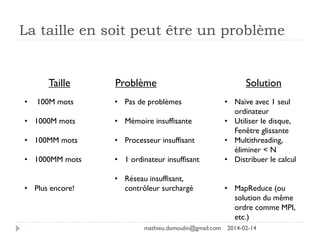

![Map et Reduce: la paire Clef-Valeur
Mapper:
(K,V) → (K’, V’)
Reducer:
(K’, [V’, V’,…]) → (K’’, V’’)
Données
(HDFS)
Données’
(HDFS)
mathieu.dumoulin@gmail.com 2014-02-14](https://image.slidesharecdn.com/introductionauxalgorithmesmapreduce-140611210400-phpapp02/85/Introduction-aux-algorithmes-map-reduce-11-320.jpg)


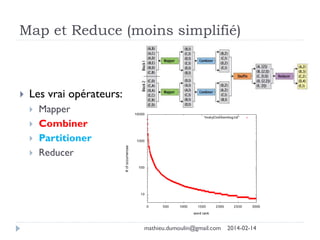
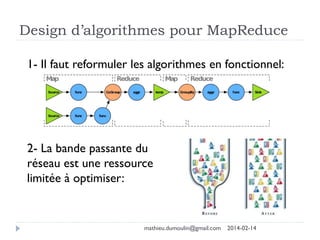

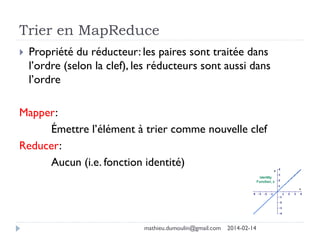
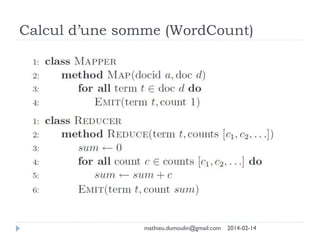

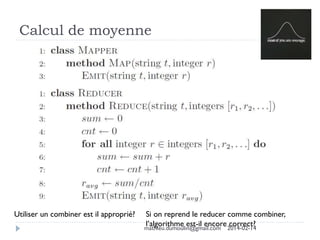

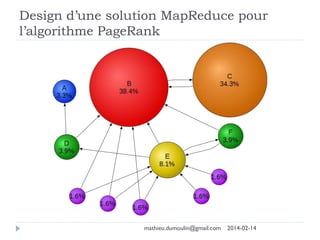
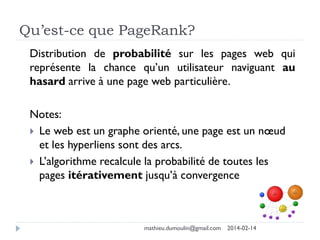


![PageRank en MapReduce
Donnés de départ:
collection de pages web (URL, [URLlien])
1. Bâtir et initialiser le graphe
2. Jusqu’à convergence, recalculer PageRank pour chaque
page web
3. Retourner les K premières valeurs de PageRank (pas
présenté)
mathieu.dumoulin@gmail.com 2014-02-14](https://image.slidesharecdn.com/introductionauxalgorithmesmapreduce-140611210400-phpapp02/85/Introduction-aux-algorithmes-map-reduce-26-320.jpg)
![Étape 1: Bâtir le graphe
Mapper:
Entrée: une page web
Pour chaque lien de la page, émettre:
clef: URLpage
valeur: URLlien
Reducer:
Entrée:
clef: URLpage
valeurs: [URLlien, …]
Sortie:
clef: URLpage
valeur: «PR;[URLlien]»
mathieu.dumoulin@gmail.com 2014-02-14](https://image.slidesharecdn.com/introductionauxalgorithmesmapreduce-140611210400-phpapp02/85/Introduction-aux-algorithmes-map-reduce-27-320.jpg)
![Étape 2: calculer PageRank - Map
Mapper:
Entrée:
clef: URLpage
valeur: «PR;[URLlien,…]»
Sortie:
Pour chaque URLlien, émettre:
clef: URLlien
valeur: «URLpage;PR, nb_urllien»
Où: nb_urllien est le compte de URLlien
mathieu.dumoulin@gmail.com 2014-02-14](https://image.slidesharecdn.com/introductionauxalgorithmesmapreduce-140611210400-phpapp02/85/Introduction-aux-algorithmes-map-reduce-28-320.jpg)
![Étape 2: calculer PageRank - Reduce
Reducer:
Entrée:
clef: URLpage
valeurs: [«URLinverse;PR, nb_urlpage_inverse», …]
Traitement: calculer le PR
Sortie:
clef: URLpage
valeurs: « PR;[URLlien]»
mathieu.dumoulin@gmail.com 2014-02-14](https://image.slidesharecdn.com/introductionauxalgorithmesmapreduce-140611210400-phpapp02/85/Introduction-aux-algorithmes-map-reduce-29-320.jpg)

